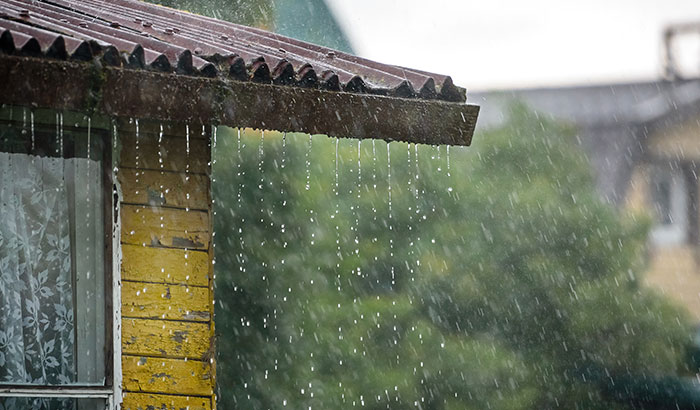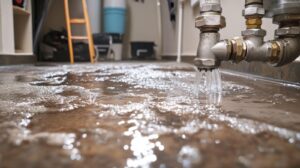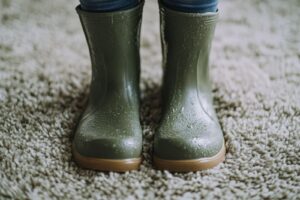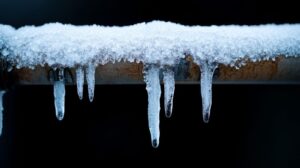Rainwater is one of the many sources of water that can find its way inside your home and cause water damage. There are multiple ways rainwater can get into your house, so identifying how it gets inside can be a bit tricky.
Unlike a plumbing issue like a burst pipe that can be identified and addressed by shutting off the main water valve while the necessary repairs are made, leaking rainwater may not be readily apparent before water damage occurs.
The best way to prevent rainwater from coming into your house is to maintain the exterior of your home from top to bottom. Both the structural and functional components of your home’s exterior should be inspected at least once a year, if not semi-annually or with seasonal changes.
During this inspection, you should look for damaged or worn areas and pieces, collected dirt or debris, overgrown trees and plants, and any unsealed openings to the interior of your home. If repairs or replacements are required, it’s a good idea to resolve issues as quickly as possible because you never know when rainclouds might visit.
If the exterior of your home is properly sealed and maintained with the correct materials, there is no reason why rainwater should be a problem. Here are some of the most common issues that can lead to unwanted rainwater in your home.
Run-Down Roof
Most roofs can last 20 to 30 years, but that doesn’t mean you can count on that amount of time before taking a closer look at your roof. A quick inspection a couple of times each year can alert you to small issues that can quickly and effectively be resolved and extend the life of your roof.
Roof shingles are the first level of protection on the top of your home and can be damaged by extreme weather conditions, overgrown foliage, climate, or other factors. Because of the way shingles are laid in an overlapping design, even a couple of damaged shingles can be problematic. The good news is that replacing shingles can be a pretty simple project.
It’s also a good idea to inspect the status of the waterproofing material underneath the shingles just to maintain the integrity of your roof and prevent water damage to the structure underneath.
Garbage in the Gutters
Attached to your roof is a system of rain gutters that functions to collect water run-off from your roof and direct it to specific locations to drain properly without collecting and causing water damage to your home. Making sure the entire system is functioning properly is crucial to preventing rainwater from entering your home.
A common problem that occurs with these rain gutters is blockages created by collected leaves and other debris. It’s particularly important to address this issue during the autumn season as the leaves are falling and blown into different areas, but detritus can collect at any time throughout the year.
Because it usually requires getting up on a ladder and can be a tedious task, cleaning your gutters is probably not your favorite task on your to-do list. However, the more often the gutters are cleaned out, the less likely they will get clogged or overflow and cause flooding and water damage to your home.
Directed Downspout
A specific piece of your roof’s drainage system is the downspout. This pipe-like device is installed on the side of your home and connects to the gutters on your roof to create a pathway for water to drain properly.
When decluttering your gutters, it is also important to ensure that water flows directly to the downspout. Once that is complete, the next step is to make sure water is flowing down through the downspout. Sometimes dirt and debris, or even a spider, might make its way into the downspout and may need to be flushed out.
The final part of inspecting and maintaining your rain gutters and downspouts is to make sure the water is being directed to the correct area for proper drainage.
If the downspout is not aimed in the right direction, it can send water toward the foundation instead of away from it. While they are installed with hardware to secure the structure against the side of your home, the downspout can be moved or angled by weather, pets, a stray soccer ball, or any myriad of other causes.
This problem can usually be fixed quickly by twisting the downspout back but may require some additional hardware to keep it in the correct placement.
Weeping Windows
Windows are a valuable asset to your home. They provide natural light, a view to the outside from the comfort inside your home, and dynamic design elements to both the exterior and interior of the house.
Windows are also a common source of water leaks into your home. When sealed properly, windows should not let water or air in or out. This sealing is accomplished using the correct size of window and frames and weatherstripping or caulk.
The entire perimeter of the window should have an airtight, waterproof seal using caulk. If a window opens, there should be an airtight, waterproof mechanism for when the window is closed. This is usually a layer of weatherstripping.
Damaged Doors
Similar to windows, doors also require the correct installation and maintenance to ensure water does not leak into your home.
In the case of doors, it is important for the weatherstripping to be effective and still allow the functionality of doors opening and closing. Choosing the right threshold and door sweep is extremely important, and weatherstripping should be applied to the entire door jamb.
Apply the weatherstripping in one continuous piece, if possible. If the entire perimeter can’t be done in one pieces, ensure that each individual side is one continuous piece. Having breaks in the weatherstripping material, even if the pieces overlap, can prevent the seal from being both waterproof and airtight.
Black Diamond Water Damage & Restoration
The best way to stop rainwater from coming into your home is to stay up to date on your home’s maintenance and repairs. However, if you do discover water leaks and accompanying water damage, call Black Diamond Water Damage & Restoration today!







